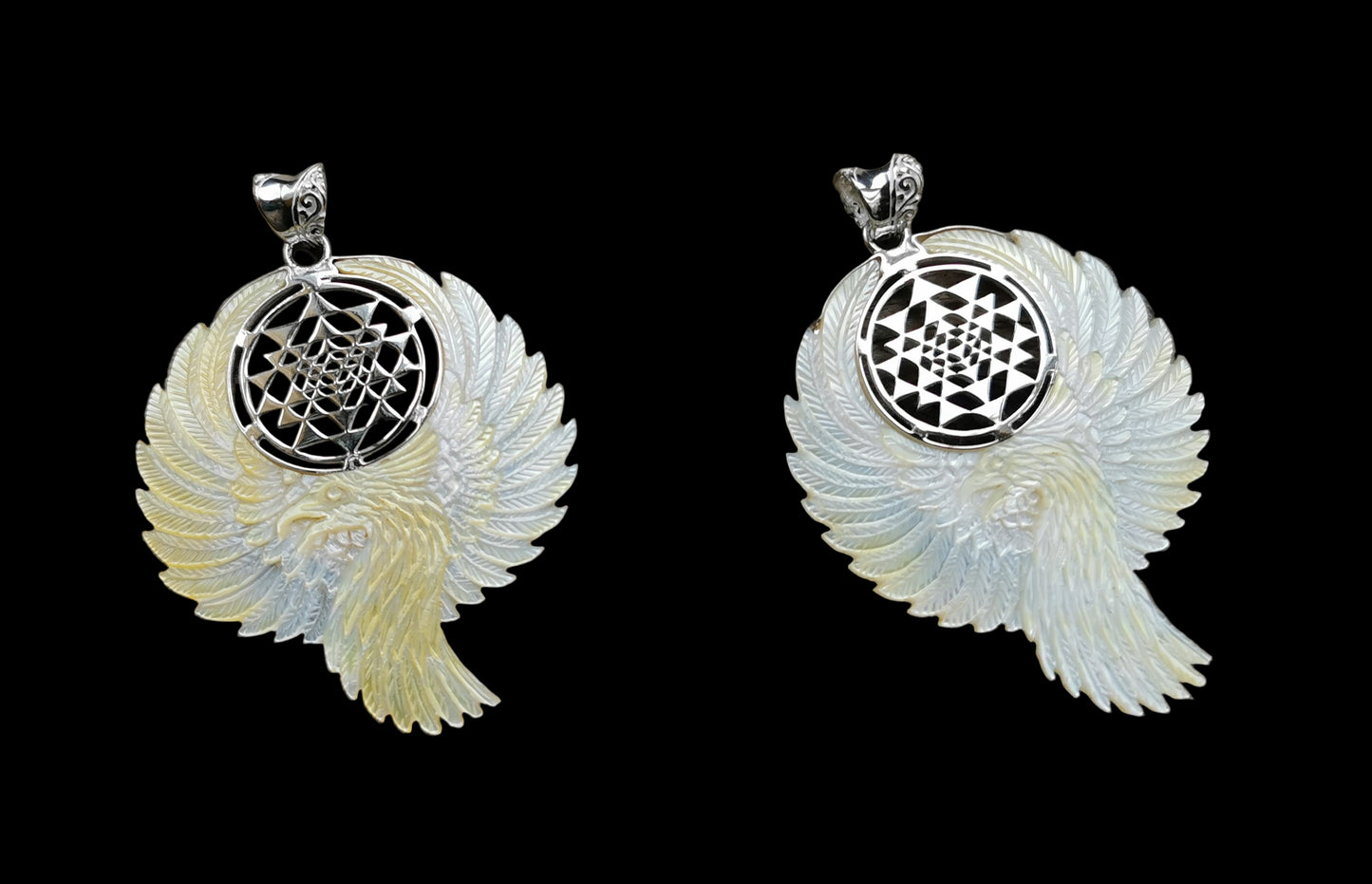Portal Glastonbury
Ref.PD0952
Ref.PD0952
Couldn't load pickup availability
Ref.PD0952 - Mother of pearl carved phoenix pendant with Sri Yantra geometry in silver.
The phoenix is a transcendent symbol revered across cultures, embodying renewal, resurrection, and immortality. This mythical bird, which bursts into flames only to rise reborn from its ashes, encapsulates the eternal cycle of death and rebirth. Its rich symbolism resonates deeply, offering profound spiritual, cultural, and psychological insights into the human experience.
Transformation and Rebirth: The phoenix represents the ability to overcome profound adversity, emerging revitalized after destruction. It reflects personal growth, reinvention, and the resilience to embrace new chapters, making it a powerful metaphor for individuals recovering from trauma or societal upheavals seeking renewal.
Eternal Life and Immortality: Its cyclical rebirth connects it to themes of eternal life, the soul’s enduring nature, and spiritual transcendence. Often tied to divine or cosmic forces, the phoenix symbolizes the persistence of existence beyond physical death, inspiring awe and contemplation.
Hope and Renewal: As a beacon of optimism, the phoenix symbolizes hope amid despair, promising fresh beginnings after loss. Its story uplifts those facing dark times, offering a vision of light and possibility.
Fire and Purification: The flames of the phoenix signify purification, consuming the old to make way for the new. This process is often linked to spiritual cleansing, emotional healing, or transformative growth, where destruction becomes a catalyst for creation.
Strength and Resilience: Rising triumphantly from its ashes, the phoenix embodies unwavering endurance and the capacity to conquer challenges. It serves as an emblem of inner fortitude and the human spirit’s ability to thrive against all odds.
Cultural Contexts:
Greek and Roman Mythology: Described by Herodotus and Ovid, the phoenix symbolized renewal and the soul’s eternal essence. Its connection to the sun’s daily cycle underscored themes of continuity and regeneration.
Chinese Mythology: The fenghuang, a phoenix-like creature, symbolized virtue, harmony, and balance. Often paired with the dragon, it represented imperial power, feminine grace, and the union of yin and yang.
Alchemy: In alchemical traditions, the phoenix represented the philosopher’s stone, the process of spiritual refinement, and the attainment of enlightenment, symbolizing the transformation of base elements into divine essence.
Modern Symbolism:
In contemporary contexts, the phoenix remains a potent symbol in literature, film, and pop culture. In J.K. Rowling’s Harry Potter, Fawkes the phoenix heals with tears and regenerates, embodying loyalty and renewal. In Marvel’s X-Men, Jean Grey’s transformation into the Phoenix represents both destructive power and redemptive rebirth. Beyond fiction, the phoenix inspires real-world metaphors, such as cities rebuilding after disasters (e.g., Atlanta’s resurgence after the Civil War) or individuals recovering from personal crises. It symbolizes societal renewal, personal transformation, and the enduring human spirit’s capacity to rise above adversity.
The phoenix’s universal appeal lies in its ability to speak to both individual and collective experiences, offering a timeless narrative of hope, resilience, and the transformative power of renewal. Its image continues to inspire art, literature, and personal journeys worldwide.
The Sri Yantra is a complex geometric figure from ancient Indian tradition, often regarded as a symbol of balance, harmony, and interconnectedness. Its structure consists of nine interlocking triangles that form a central point, surrounded by concentric layers of petals, gates, and an outer square. Here's a breakdown of its symbolism, focusing on its abstract and universal qualities rather than specific cultural or spiritual references:
Triangles: The nine triangles, with some pointing upward and others downward, represent the interplay of opposites—such as expansion and contraction, energy and matter, or movement and stillness. Their interlocking nature suggests unity and interdependence, illustrating how seemingly opposing forces can coexist and complement each other.
Central Point (Bindu): The dot at the heart of the Sri Yantra symbolizes a focal point of concentration, potential, or origin. It can be seen as the seed from which the entire structure emerges, embodying wholeness and the essence of creation in its simplest form.
Petals: The layers of petal-like shapes surrounding the triangles often evoke cycles, growth, and progression. They suggest an unfolding process, like the blossoming of complexity from a single source, emphasizing continuity and evolution.
Gates and Outer Square: The square perimeter with its four openings, or "gates," facing cardinal directions, conveys stability, structure, and boundaries. It frames the inner complexity, symbolizing a grounded foundation that contains and supports dynamic energy.
Symmetry and Balance: The Sri Yantra’s precise symmetry reflects harmony and equilibrium. Its intricate design invites contemplation of order within chaos, as the overlapping shapes create a sense of both movement and stability.
Fractal-like Quality: The repeating patterns and self-similar forms within the Sri Yantra hint at the concept of infinity and the interconnectedness of all scales, from the smallest point to the larger whole.
In essence, the Sri Yantra can be viewed as a visual representation of complexity arising from simplicity, the unity of opposites, and the balance between containment and expansion. It’s a tool for reflection, encouraging an understanding
Size: 60mm/2.36in approx.


